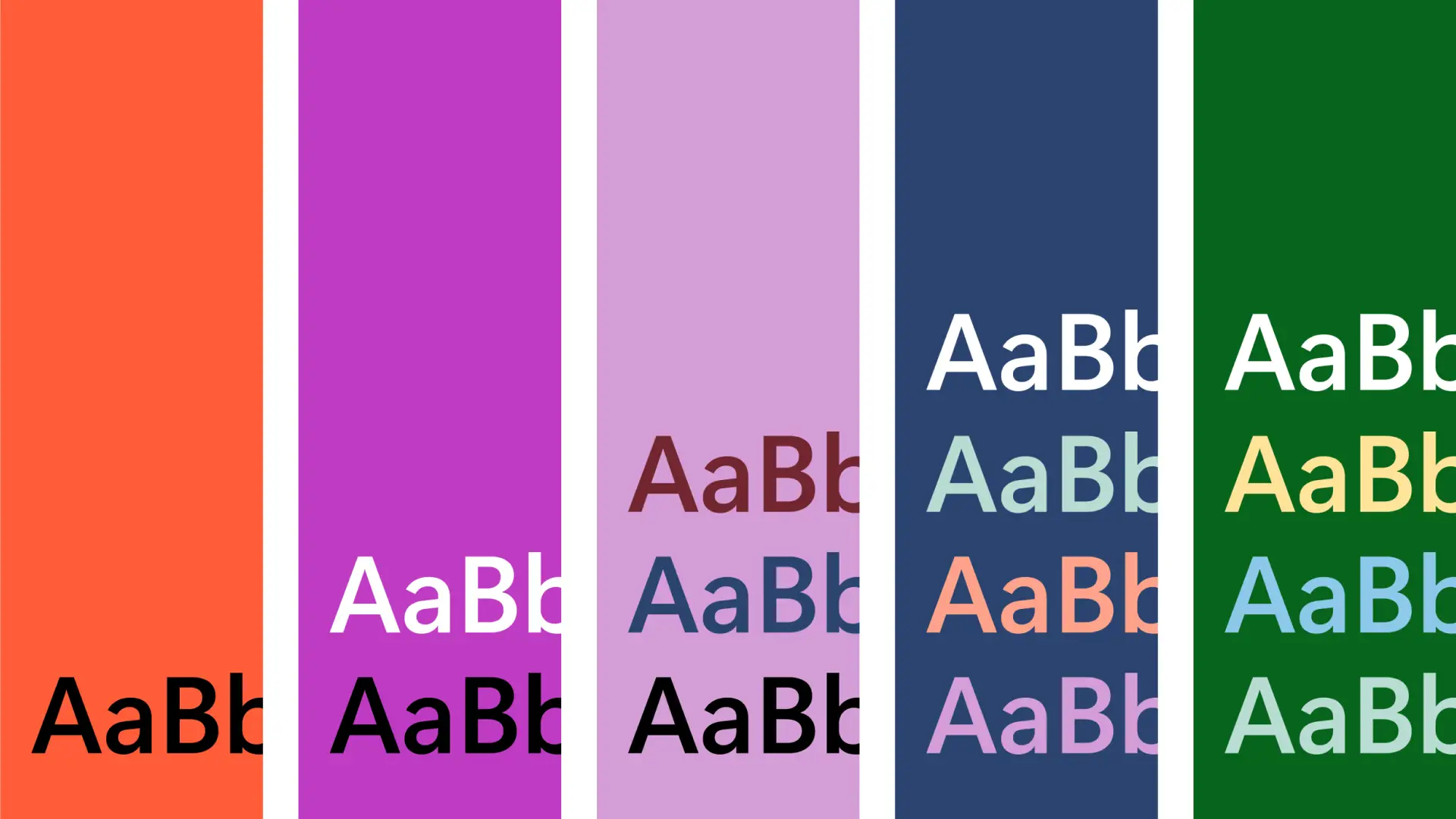On this page
What are brand guidelines?
Brand guidelines harmonize your company’s visual and verbal identity through icon usage, typography, colors, photos, and messaging. Brand guidelines only work if they're used, so yours should include examples and digital assets for team members and agencies to draw from. Effective brand guidelines also include directions on how to implement specific elements and what not to do.
How to create brand guidelines
Brand guidelines can empower teams to create content that looks, feels, and sounds like your organization. Perhaps you've introduced a new tagline or logo, but the old messaging is still around? Brand guidelines can take away the confusion and need for reminders on what’s right to use.
That said, some messaging could slip through the cracks even if you have brand guidelines. A brand guide isn't helpful if it’s lost in a forgotten folder. Create a collaborative set of brand guidelines that you can keep updated with Microsoft PowerPoint. The digital format allows you to incorporate examples and link to supporting assets like social media templates and email signatures. Put your professionalism on display with well-branded work content that reflects your company well.
Read on to learn what brand guidelines include and how to make them usable. To get started, open a simple PowerPoint presentation template and customize the layout and visuals with the brand guideline components below.
Brand style guide vs. brand book
Brand guidelines sometimes go by other names like brand guide or brand book. These are interchangeable. The term 'brand book' calls back to a time when branding executives would create guidelines in physical books. You might also come across the terms brand style guide and brand kit. These tend to embody the visual elements of brand guidelines, like the logo, fonts, colors, photos, and icons.
Why are brand guidelines important to have and use?
Brand guidelines create a cohesive experience between visuals and messaging to inspire trust and loyalty in your customers. Without a brand guide, your website could set a different tone from your presentation decks and social media posts.
The same goes if you have guidelines but don’t use them. This could confuse people or even cause them to question your reliability. For example, a sales team might look unprofessional if some agents don’t follow the brand tone of voice or use hard sell tactics that don’t fit. Or, a university could lose trust in the eyes of prospective students if the admissions site, school social media accounts, and course guide all have different logos or designs.
Having clear brand guidelines puts all creators and designers on the same page. Whatever content your PR, sales, content marketing, and customer service teams produce will feel like your brand.
What should brand guidelines include?
Brand guidelines should include the following:
Core brand identity
Logo and usage
Brand fonts
Color palette
Imagery and icons
Voice and messaging
Real-life examples
Digital assets
Depending on your company’s niche, you might focus on one of these areas more than another. But they’re all important to create a full brand guide. Let’s walk through each next.
1. Core brand identity
This is the genesis of your brand. Why does it exist? Start here and the brand guidelines will fall into place. Brand identity includes things like:
Brand purpose: why does your brand exist (beyond money)?
Mission statement: what does your brand do?
Vision statement: what do you hope to change or achieve?
Core values: what are your guiding principles?
Brand personality: what human traits does it embody?
2. Logo and usage
Next, nail down your primary logo design, noting rules for resolution and space requirements. Create alternate versions for small spaces, grayscale, and simplified icon design. Clearly define misuses of your logo, like distorting the proportions, using the wrong version for a channel, changing color, or displaying it with a transparent background. The wrong logo could show up pixilated on certain devices and look unprofessional. Similarly, using random colors weakens your logo’s impact. A consistent logo strategy helps customers learn your brand identity across media.
3. Brand fonts
Custom fonts can help create a lasting brand image, especially when you're consistent across your website, business cards, portfolios, trade show materials, and pitch decks. Detailed guidelines maximize your investment in creating a custom font. Take the time to detail exactly how to upload and use it on different devices and types of media.
You might have a main font and one or two supporting versions for different applications. Include usage examples in your brand guidelines along with web font details like spacing, weight, slant, size, and line height. One popular scheme is to use a serif font for headings and sans serif for body text. You might want a unique subtitle or quote block font, too.
4. Color palette
People can get a feel for your band in milliseconds just by perceiving your colors. Take time to build a color palette that reflects your brand’s emotions. You’ll see most brands use three or four colors, though some use more. Pick a leading color, one or two supporting colors, and an accent color that you use sparingly. Make your colors accessible for all readers by following contrast guidelines. Include the following information for each color in your brand guide:
A visual color swatch
The color’s PANTONE designation
CMYK percentages for print media
HEX and RGB codes for digital media
This facilitates consistent colors across different types of digital and print media, and can be represented in presentation slide backgrounds.
5. Imagery and icons
Next, define your visual styles with photos, graphics, and icons. Does your brand use natural photography or studio-lit images and heavy processing? Are your graphics in a Corporate Memphis style or 3D? Describe your icon style, whether it uses curved edges or thin lines. Then, include a folder of approved stock media to make life easier for employees.
6. Voice and messaging
Voice and messaging are responsible for much of your brand’s personality in the minds of consumers. When someone reads your content, do they visualize a friendly neighbor or reputable advisor? Your brand’s tone of voice encapsulates this emotional undertone. Your audience might connect with a casual or witty tone over something more formal, even if the subject matter is dry. Or, perhaps you want to make an impression with an irreverent tone that goes against the grain in the industry. Two companies can say the same thing in different ways and connect with audiences completely differently. The key is to stay consistent.
Include the following in your brand book:
A short tagline
Your elevator pitch
Messaging pillars to guide content
Tone of voice (casual, witty, irreverent, etc.)
Style rules on contractions, punctuation, emojis, and more
7. Real-life examples
Your brand guidelines should include examples to show them in action. Think about including examples of business cards, letterheads, email signatures, webpage layouts, social media templates, packaging, and PowerPoint presentations slide decks.
8. Digital assets
Along with examples, provide digital resources for your team. If you use PowerPoint for your brand guidelines, you can include links to files on OneDrive or in other storage locations. Assets can include downloadable logos, color libraries, cover photos for social media profiles, favicons, meeting backgrounds, and more. Linking assets like these to your brand guidelines makes it easy to update them if you change visuals at any point.
How to create brand guidelines within PowerPoint
PowerPoint is an easy and versatile option for creating brand guidelines. You can share the presentation with team collaborators and provide view-only permissions to branding agencies, freelancers, and subcontractors who may need it. Here’s how to get started:
Open Microsoft PowerPoint
Start a blank presentation or choose a simple template to modify
Add slides corresponding to core identity, logo, typography, color palette, imagery, messaging, examples, and assets
Format the slides with colors, images, and fonts
Have Copilot in PowerPoint review your content for clarity and conciseness
Share viewing or editing permissions with stakeholders
To begin with a template, try this marketing presentation template or modern geometry design template as a starting point.
Copilot tip: add your organization's brand template to an Organization Asset Library to enable employees to create on-brand content with Copilot. Once your organization’s template is added, employees can select the organization's presentation template as the design for Copilot to use when creating a presentation or generating a slide for a specific topic.
Frequently asked questions
What are the five brand guidelines?
Five key factors to include in brand guidelines are your logo design, typography, color palette, imagery, and messaging. It’s recommend starting with your brand identity and including real-life examples and digital assets in your guidelines.
How many fonts should a brand have?
Most brands have about two or three fonts. Any more than that and you could confuse readers. However, you’ll want to have multiple font styles, like a heavy-weight version for certain heading levels or an italic version for block quotes.
What is brand positioning?
Positioning a brand involves carving out a unique place for it in the minds of consumers. Brand positioning describes what makes the company the best in its niche for specific buyers compared to its competitors.
What is a brand guidelines template?
A brand guidelines template helps your nail down your logo, typography, color palette, messaging, and imagery in a presentation or document format. You can also use the brand guide components we outlined above and apply them to a PowerPoint presentation.
What is another name for brand guidelines?
Brand guidelines are often called brand guides or brand books. You might also see brand style guides and brand kits used interchangeably, though these tend to focus more on the visual aspects of a brand’s identity.
What is the 60-30-10 color rule in branding?
The 60-30-10 color rule is a guideline to use a main color 60%, a supporting color 30%, and an accent color 10% of the time. The idea is to create a sense of visual balance in your color palette.







